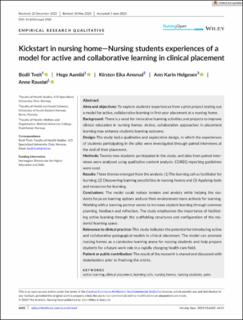| dc.contributor.author | Tveit, Bodil | |
| dc.contributor.author | Aamlid, Hege Ingeborg | |
| dc.contributor.author | Amsrud, Kirsten Eika | |
| dc.contributor.author | Helgesen, Ann Karin | |
| dc.contributor.author | Raustøl, Anne | |
| dc.date.accessioned | 2023-10-26T11:01:24Z | |
| dc.date.available | 2023-10-26T11:01:24Z | |
| dc.date.created | 2023-06-19T13:35:05Z | |
| dc.date.issued | 2023 | |
| dc.identifier.citation | Nursing Open. 2023, 10 (9), 6602–6613 | en_US |
| dc.identifier.issn | 2054-1058 | |
| dc.identifier.uri | https://hdl.handle.net/11250/3098917 | |
| dc.description | This is an open access article under the terms of the Creative Commons Attribution-NonCommercial-NoDerivs License, which permits use and distribution in any medium, provided the original work is properly cited, the use is non-commercial and no modifications or adaptations are made. | en_US |
| dc.description.abstract | Aims and objectives: To explore students' experiences from a pilot project testing out a model for active, collaborative learning in first-year placement at a nursing home.
Background: There is a need for innovative learning activities and projects to improve clinical education in nursing homes. Active, collaborative approaches in placement learning may enhance students learning outcome.
Design: The study had a qualitative and explorative design, in which the experiences of students participating in the pilot were investigated through paired interviews at the end of their placement.
Methods: Twenty-two students participated in the study, and data from paired inter-views were analysed using qualitative content analysis. COREQ reporting guidelines were used.
Results: Three themes emerged from the analysis: (1) The learning cell as facilitator for learning; (2) Discovering learning possibilities in nursing homes and (3) Applying tools and resources for learning.
Conclusions: The model could reduce tension and anxiety while helping the stu-dents focus on learning options and use their environment more actively for learning. Working with a learning partner seems to increase student learning through common planning, feedback and reflection. The study emphasises the importance of facilitat-ing active learning through the scaffolding structures and configuration of the stu-dents' learning space.
Relevance to clinical practice: This study indicates the potential for introducing active and collaborative pedagogical models in clinical placement. The model can promote nursing homes as a conducive learning arena for nursing students and help prepare students for a future work role in a rapidly changing health care field.
Patient or public contribution: The result of the research is shared and discussed with stakeholders prior to finalising the article. | en_US |
| dc.language.iso | eng | en_US |
| dc.publisher | Wiley | en_US |
| dc.rights | Attribution-NonCommercial-NoDerivatives 4.0 Internasjonal | * |
| dc.rights.uri | http://creativecommons.org/licenses/by-nc-nd/4.0/deed.no | * |
| dc.subject | pairs | en_US |
| dc.subject | nursing students | en_US |
| dc.subject | nursing homes | en_US |
| dc.subject | learning cells | en_US |
| dc.subject | clinical placement | en_US |
| dc.subject | active learning | en_US |
| dc.title | Kickstart in nursing home-Nursing students experiences of a model for active and collaborative learning in clinical placement | en_US |
| dc.type | Peer reviewed | en_US |
| dc.type | Journal article | en_US |
| dc.description.version | publishedVersion | en_US |
| dc.rights.holder | © 2023 The Authors. Nursing Open published by John Wiley & Sons Ltd. | en_US |
| dc.source.pagenumber | 6602–6613 | en_US |
| dc.source.volume | 10 | en_US |
| dc.source.journal | Nursing Open | en_US |
| dc.source.issue | 9 | en_US |
| dc.identifier.doi | 10.1002/nop2.1920 | |
| dc.identifier.cristin | 2155865 | |
| cristin.ispublished | true | |
| cristin.fulltext | original | |
| cristin.qualitycode | 1 | |

